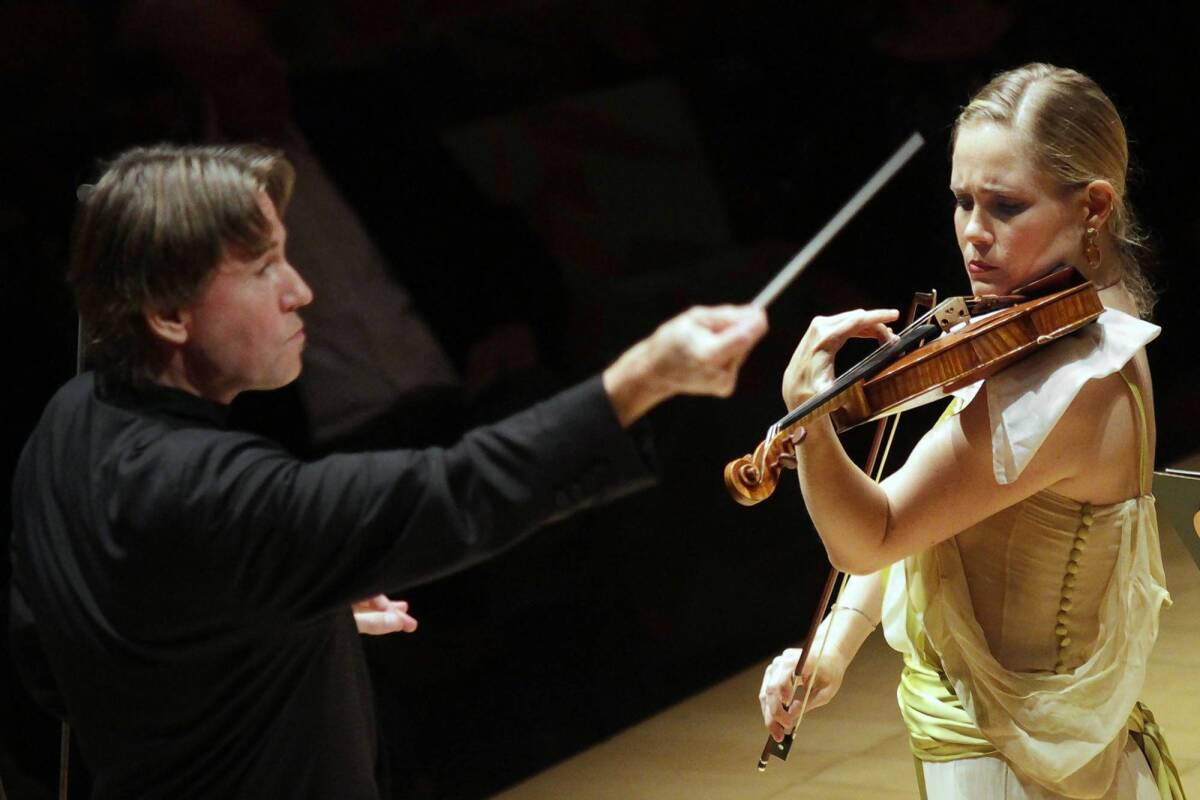Review: Esa-Pekka Salonen rekindles his romance with the L.A. Phil

Esa-Pekka Salonen’s Violin Concerto was finished and given its first performance at Walt Disney Concert Hall in spring 2009, during his feverish and emotional final days as music director of the Los Angeles Philharmonic. Salonen said it wasn’t a farewell concerto.
Of course it was.
His most personal score, the concerto is a mindful realization of all Salonen became as a conductor and composer during his 17 years living in L.A. He let himself go in a hooray-for-L.A. third movement, for which he added a rock drum kit and at the end instructed the drummer to “go crazy.”
PHOTOS: Arts and culture in pictures by The Times
“Adieu,” the title of the bittersweet Finale, could mean only one thing. Or so it seemed at the time.
Salonen brought the concerto back to Disney this past weekend as part of the orchestra’s celebration of the 10th anniversary of Disney Hall. Leila Josefowicz, for whom the work was written, was once more the irrepressible soloist.
The work has been a huge success. Salonen and Josefowicz have played it around the world (next week they take it to the New York Philharmonic) and recorded it. In 2012, the concerto received the Grawemeyer Award, the most prestigious international composition prize.
The performance Saturday night was on every level a sensation. Now the L.A. Phil laureate conductor, Salonen exalted in the chromatic extravagance and rhythmic flexibility he helped instill in the orchestra. The concert hall mattered too. Nowhere else, for instance, can the ultra-low otherworldliness of the contrabass clarinet, a Salonen specialty, create quite the same wondrous atmosphere. Little ever inhibits Josefowicz, but in Disney’s casual intimacy, cutting loose needn’t be unnecessarily shocking.
The Violin Concerto poses, perhaps, the question: What’s next? Written the year he turned 50, it is ultimately a portrait of Salonen’s life in this city and the ways L.A. liberated him musically.
FULL COVERAGE: Walt Disney Concert Hall at 10
In the first movement, called “Mirage,” the orchestra operates like a zoom lens, while the violinist is a gazelle-like post-Minimalist moving target.
The second movement, “Pulse I,” is meant to evoke awakening in the quiet dawn. A timpani heartbeat keeps a pulse. The solo violin is the sleeper’s nervous system, finding her own rhythm. The orchestra sounds far away, a distant world turning at its own rhythm. “Pulse II,” with the rock drummer, is urban. In a raucous duo, Josefowicz and principal violist Carrie Dennis were like two daunting women tearing up the town.
The last movement is the longest and maybe the most emotionally direct that a cool composer has yet written. But it ends with a surprising chord, a hedge against sentimentality, a promise of a new beginning. Josefowicz easily impresses as a classical player who can rock. But she is even more impressive as a classical player who can, as in this “Adieu,” soar.
Soar she did.
As for the new beginning, now that is more hello than goodbye. One of Salonen’s stated reasons for leaving the L.A. Phil was to be able to spend more time composing. But during his past four years in London, where he is principal conductor and artistic advisor of the Philharmonia Orchestra, he has written only a 20-minute orchestra piece (“Nyx”) and a five-minute work for children’s chorus. This fall, though, Salonen has once more made L.A. his principal residence, realizing that here is where his inspiration lies.
CHEAT SHEET: Fall arts preview 2013
The program began with Charles Ives’ “The Unanswered Question,” another remembrance of Salonen’s L.A. He had conducted it 10 years ago on Disney Hall’s opening night. The stage was bare. An ethereal string sound, from players high up in the rear balcony, floated mystically overhead. A solo trumpet, out of sight, blurted out existential musical questions. Four flutes, standing in the organ loft, nervously sought answers.
Sibelius’ Fifth Symphony ended the concert with answers for unasked questions. The performance was galvanic. Salonen regulated orchestral textures as though they were sonic rapids. Waves of different viscosities overlapped and crashed. There was play in the middle movement, just as there is play in Salonen’s own music. But it was the vastness of a great performance that overwhelmed.
If I had to choose the most probing, most original, most personal and most sonically tactile performance of any symphony I’ve heard this year, Salonen’s Sibelius Fifth wins hands down. But I can’t really tell you why. Sometimes words won’t do.
More to Read
The biggest entertainment stories
Get our big stories about Hollywood, film, television, music, arts, culture and more right in your inbox as soon as they publish.
You may occasionally receive promotional content from the Los Angeles Times.











